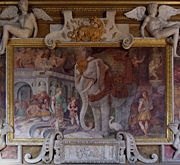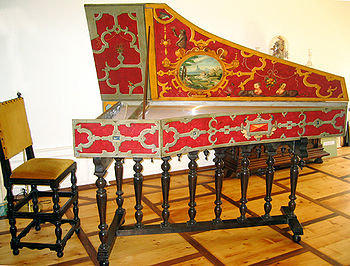
Strapwork
Encyclopedia


Ornament
An ornament is something used for decoration.Ornament may also refer to:*Christmas ornaments, an ornament hung from a Christmas tree*Ornament , purely decorative elements in architecture and the decorative arts*Ornament *Ornamental plant...
of strips or bands of curling leather
Leather
Leather is a durable and flexible material created via the tanning of putrescible animal rawhide and skin, primarily cattlehide. It can be produced through different manufacturing processes, ranging from cottage industry to heavy industry.-Forms:...
, parchment
Parchment
Parchment is a thin material made from calfskin, sheepskin or goatskin, often split. Its most common use was as a material for writing on, for documents, notes, or the pages of a book, codex or manuscript. It is distinct from leather in that parchment is limed but not tanned; therefore, it is very...
or metal cut into elaborate shapes, with piercings and often interwoven. Strapwork is a frequent element of grotesque
Grotesque
The word grotesque comes from the same Latin root as "Grotto", meaning a small cave or hollow. The original meaning was restricted to an extravagant style of Ancient Roman decorative art rediscovered and then copied in Rome at the end of the 15th century...
s -- arabesque or candelabra
Candelabra
"Candelabra" is the traditional term for a set of multiple decorative candlesticks, each of which often holds a candle on each of multiple arms or branches connected to a column or pedestal...
figures filled with fantastical creatures, garlands and other elements -- which were a frequent decorative motif in 16th century Mannerism
Mannerism
Mannerism is a period of European art that emerged from the later years of the Italian High Renaissance around 1520. It lasted until about 1580 in Italy, when a more Baroque style began to replace it, but Northern Mannerism continued into the early 17th century throughout much of Europe...
, and revived in the 19th century and which may appear on walls -- painted, in fresco
Fresco
Fresco is any of several related mural painting types, executed on plaster on walls or ceilings. The word fresco comes from the Greek word affresca which derives from the Latin word for "fresh". Frescoes first developed in the ancient world and continued to be popular through the Renaissance...
s, carved in wood, or molded in plaster or stucco
Stucco
Stucco or render is a material made of an aggregate, a binder, and water. Stucco is applied wet and hardens to a very dense solid. It is used as decorative coating for walls and ceilings and as a sculptural and artistic material in architecture...
-- or in graphic work.
Strapwork was found earlier, but really came to prominence after it was used in stucco
Stucco
Stucco or render is a material made of an aggregate, a binder, and water. Stucco is applied wet and hardens to a very dense solid. It is used as decorative coating for walls and ceilings and as a sculptural and artistic material in architecture...
in the enormous elaborate decorative frames designed by Rosso Fiorentino
Rosso Fiorentino
Giovanni Battista di Jacopo , known as Rosso Fiorentino , or Il Rosso, was an Italian Mannerist painter, in oil and fresco, belonging to the Florentine school.-Biography:...
for the Palace of Fontainebleau in the 1530s. Thereafter, spread by prints, it became part of the vocabulary of Northern Mannerist ornament. Where there is no suggestion of three dimensions - curling ends and the like - the decoration may also be called bandwork or "interlaced bands", the more technically correct term. Peter Fuhring derives this style from Islamic ornament.

